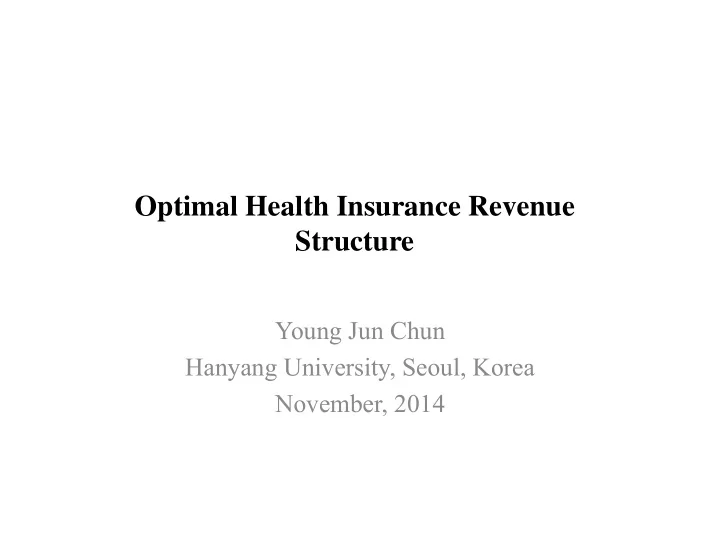

Optimal Health Insurance Revenue Structure Young Jun Chun Hanyang University, Seoul, Korea November, 2014
Motivation • Increasing dependence of health insurance revenue on subsidies from other sectors of government – Rapid increase in health insurance (HI) expenditure due to population aging – Population aging also reduces revenue base for HI contributions
More dependence on the government subsidy means: – Reducing labor income tax – Increasing capital income tax and consumption tax – Because: • HI contribution is typically imposed on labor income (or non-capital income) • The source of the government subsidy is tax revenue, which consists of labor income tax, capital income tax, and consumption tax
Economic effects of the tax base change • Any possibility of increasing health expenditure? • From political economy perspective (Persson and Tabellini, 1999): • Tax burden is generally progressive • HI contribution is generally regressive, because of the existence of an income ceiling for HI contributions • Revenue-neutral increase in tax-financing will reduce the median voter’s fiscal burden, which will make her vote for larger HI expenditure
Related to median voter theorem • Two Hypotheses: (A)Proportion of PHI-contribution-financing has positive relationship to public (or national) health expenditure (B) Proportion of PHI-contribution-financing is negatively related to progressivity
Estimation equations National health expenditure and public health expenditure – Fixed Effect Model with year dummies – 2-stage estimation – IV: PHI contribution proportion (Sov_Gov) • Possibility of endogeneity • Government may adjust based on projected increase in public health expenditure
• Dependent variables – National health expenditure (Tot_Exp_GDP) – Public health expenditure (Pub_Exp_GDP) • Independent variables – GDP_pc: GDP per capita – Sen_rate: Proportion aged 65 and above – OOP: Proportion of out-of-pocket payment – Soc_gov: Share of HI fund in public health expenditure – Gov_Exp: Public health expenditure share in national health expenditure
• Independent variables, continued: – Year dummy: – Tax progressivity (1) Difference between before-tax and after-tax Gini (Musgrave and Thin (1948) , [1]) (2) Kakwani (1991) index: ([2]) (1) Income elasticity of tax burden ([3]) (2) Difference in effective average income tax rate between 67%-of-average-income earner and 167%-of-average- income earner ([4]) (3) Difference in effective average income tax rate between 67%-of-average-income earner and 100%-of-average- income earner ([5])
Estimation results • An increase in tax financing or in subsidies from other sectors of the general government is likely to increase health care expenditure – Median Voter Theorem underlies the result • Then, what is the effect on welfare?
Identification of optimal HI revenue structure (General Equilibrium Model approach) • Increase in tax financing increases health expenditure, which increases the tax burden • The resulting health expenditure increase improves health (McGuire, 2000) • Growth effect of revenue-neutral increase in tax financing improves social welfare (Chun, 2012)
General Equilibrium Model • Overlapping generations model – Life expectancy: 80 years – 12 5-year periods • Household sector – 10 lifetime income classes – Decision-making: • Consumption • Health care service
Risks in health • With Prob=prL a, a person becomes ill • With Prob=prR a, a person who is ill recovers • Lose utility SH in monetary terms • Health service purchase partially compensates for the loss of utility due to illness Utility • When healthy : • When sick:
Physicians • Maximize financial profit – disutility from effort
H, ε are jointly decided by the ill person and the physician (Nash equilibrium) • Public health insurance parameters affect this joint decision • Coinsurance rate • Lump-sum payment to physician • Part of cost-sharing to physician
Firms • Constant returns to scale of production technology • Production factor: Labor supply • Perfect competition
Government • Provides public health insurance (PHI) system • Maintains balanced budget • Lump-sum payment to physician + Fee for service = PHI contribution + Tax revenue • Taxes • Progressive income tax • Proportional consumption tax • Proportional PHI contribution
Flow of decisions
Issues • Identification of optimal PHI contribution proportion – The existence of progressive income taxation induces a heterogeneous effect of PHI contribution proportion across income classes and age groups • Effect of tax revenue proportion – The proportion affects the progressivity of the tax burden across classes and age groups
Effect of population aging • As the population ages, the median voter is getting older • PHI contribution is typically not imposed on the older age groups • In an extremely old society, an increase in tax financing may reduce PHI expenditure
Recommend
More recommend